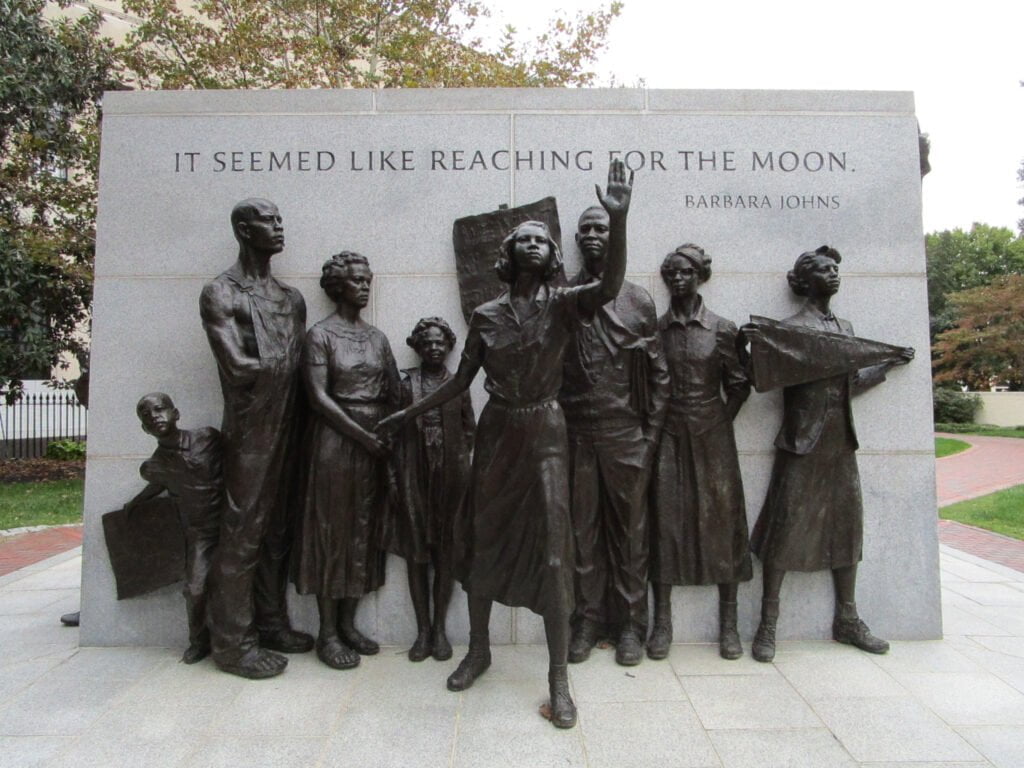Hey readers, with African American history top of mind, does the name “Barbara Johns” ring a familiar bell with you? If not don’t feel bad, you’re not alone. You see, when African American history comes up there are two realities; first, it gets compressed into February (or recently Juneteenth) and, second, it typically cites the well-deserved names as its founder Carter G. Woodson, Dr. Charles Drew, Rosa Parks, George Washington Carver, W. E. B. DuBois Dr. King and others. So, I figured that perhaps the Barbara Johns’ story of profound unprecedented courage, the focus of this narrative, may pique your interest.
But first for context, consider the following imaginary scenario.
Imagine that you, a 16-year-old, was shaken awake early one morning by your parents who told you to get dressed immediately and ready to leave the house. Within 30 minutes they took you to the bus station and whisked you off to live with relatives in another state 500 miles away. Why? Because the student protest you organized and led in opposition to the recent Supreme Court’s striking down legal abortions led to a fierce backlash, including vile phone threats to your parents and vandalism to your house.
Now put that image aside for now. Let’s shift back to Barbara Johns.
Barbara Johns Powell was born in New York City in 1935. Her family had roots in Prince Edward County, Virginia, where they returned to live. Powell’s uncle Vernon Johns was an activist and minister best known as the pastor who succeeded Dr. Martin Luther King Jr. at Dexter Avenue Baptist Church in Birmingham. Vernon was widely known for his scholarship in the classics, intellect, and outspoken sermons on race, which were ahead of his time. When he visited the family in Virginia, he would ask the children questions about Black history which motivated Barbara to study Black history.
In 1951, 16-year-old Barbara Johns was a junior at the all-Black Moton High School in Farmville. Across town was another school, open exclusively to white students. The resources available to each school and the quality of the facilities were unequal. Barbara’s sister Joan described the conditions at the Black school.

“In winter the school was very cold. And a lot of times we had to put on our jackets. When it rained, we would get water through the ceiling. It was a very difficult setting for trying to learn.”
Parents of the Black students appealed to the all-white school board to provide a larger and properly equipped facility. As a stopgap measure, the board erected several tar paper shacks to handle the overflow of Moton students.
After years of frustration Barbara took her concerns to a teacher who asked, “Why don’t you do something about it?” After months of contemplation, she formulated a plan and met with classmates who agreed to a student strike. On April 23, 1951, the plan Johns initiated was put into action.
They marched to the county courthouse to make officials aware of the differences in quality between the schools and picketed with placards proclaiming, “We want a new school or none at all” and “Down with tar-paper shacks.”
That year lawyers from the NAACP (National Association for the Advancement of Colored People) arrived to help the students. A month later, the NAACP filed Davis v. County School Board of Prince Edward County in federal court. However, the court upheld segregation in Prince Edward County. Not to be deterred, the NAACP appealed successfully to the U.S. Supreme Court, a decision that contributed to the civil rights movement.
For her part in the movement, Johns was harassed and the Ku Klux Klan burned a cross in her yard. Her parents, fearing for her safety, sent her to Montgomery, Alabama to live with her uncle Vernon.
After the strike Barbara later received a degree from Drexel University, married, raised five children and lived for the rest of her life in Philadelphia. She died in September 1991.
The Library of Virginia honored Barbara in 2005 by naming her one of their Virginia Women in History. In a 2017 interview with CBS This Morning, Governor Terry McAuliffe spoke about the Unite the Right rally in Charlottesville, Virginia, with a portrait of Barbara Johns in the background. He called the white supremacists cowards and said:
“Over my shoulder is Barbara Johns who at 16 years old led the revolt at Prince Edward County, Virginia, when we had white schools and Black schools. She said, “Our schools are inferior,” and led a revolt of 400 students in the ‘50s. That is what we need as leaders.”
In 2020, Virginia’s Commission on Historical Statues voted to recommend that a statue of Barbara Johns represent Virginia in the National Statuary Hall in place of the one of Robert E. Lee.
Now… back to the imaginary scenario presented at the beginning. Imagine that that 16-year-old depicted is today your daughter, potentially the next Barbara Johns, who is about to lead a protest against, say, the National Rifle Association; violence against Jews; Muslims; gay people; or appear before millions as a witness to the January 2021 violent insurrection at the nation’s capitol.
Humm, let that soak in for a minute!
© Terry Howard is an award-winning writer and storyteller. He is also a contributing writer with the Chattanooga News Chronicle, The American Diversity Report, The Douglas County Sentinel, Blackmarket.com, co-founder of the “26 Tiny Paint Brushes” writers’ guild, recipient of the 2019 Dr. Martin Luther King, Jr. Leadership Award and 3rd place winner of the 2022 Georgia Press Award. He can be reached at wwhoward3@gmail.com

